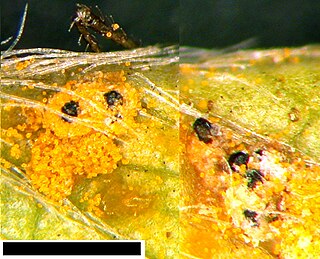
Septoria are ascomycete pycnidia-producing fungi that cause numerous leaf spot diseases on field crops, forages and many vegetables including tomatoes which are known to contract Septoria musiva from nearby cottonwood trees, and is responsible for yield losses. The genus is widespread, and estimated to contain 1072 species. Pycnidia produce needle-like pycnidiospores.
Pseudocercospora mali is a fungal plant pathogen infecting Apple trees. It was originally found on the living leaves of Pyrus malus in Louisiana, USA.
Phaeosphaeria avenaria f.sp. avenaria is a plant pathogen affecting oat. This f. sp. appears to not infect barley or rye, while their f. sp. (tritici) does not appear to infect oat.

Stagonospora is a genus of fungi clustering in the Phaeosphaeriaceae (Quaedvlieg). Several of the species in this genus are plant pathogens.

The Phaeosphaeriaceae are a family of fungi in the order Pleosporales. Species in the family have a cosmopolitan distribution, and are generally nectrotrophic or saprobic on a wide range of plants.

The Massarinaceae are a family of fungi in the order Pleosporales. Although taxa have a cosmopolitan distribution, they are better-known in temperate regions. They are thought to be saprobic in wood and bark; some species are weak pathogens.
Teratosphaeria is a genus of fungi in the family Teratosphaeriaceae; according to the 2007 Outline of Ascomycota, it was placed in the Phaeosphaeriaceae, but the placement within this family was uncertain. It was confirmed in 2020, within Teratosphaeriaceae by Wijayawardene et al. 2020.

Phaeosphaeria is a genus of fungi in the family Phaeosphaeriaceae. It has about 95 species. The genus was circumscribed by Japanese mycologist Ichiro Miyake in 1909, with Phaeosphaeria oryzae assigned as the type species.

Herpotrichiellaceae is a family of ascomycetous fungi within the order Chaetothyriales and within the class Eurotiomycetes. It contains 16 genera and about 270 species. The type genus of the family, Herpotrichiella, is now synonymous with Capronia.
Phaeoramularia is a genus of fungi in the family Mycosphaerellaceae. It was circumscribed in 1960.

Teratosphaeriaceae is a family of fungi in the order Mycosphaerellales.

Cercosporella is a fungus genus in the family Mycosphaerellaceae.

Asperisporium is a genus of ascomycete fungi whose members are plant pathogens.

Passalora is a genus of fungi in the family Mycosphaerellaceae. It has about 250 species.
Aposphaeria is a genus of fungi in the family Melanommataceae. The genus was circumscribed in 1880 by Pier Andrea Saccardo, with Aposphaeria pulviscula selected as the type species.
Mycovellosiella is a genus of fungi belonging to the family Mycosphaerellaceae.

Sporocadus is a genus of plant pathogens in the family Sporocadaceae.

Coniothyriaceae is a family of ascomycetous marine based fungi within the order of Pleosporales in the subclass Pleosporomycetidae and within the class Dothideomycetes. They are pathogenic or they can be saprobic on dead branches. They are generally a anamorphic species.











